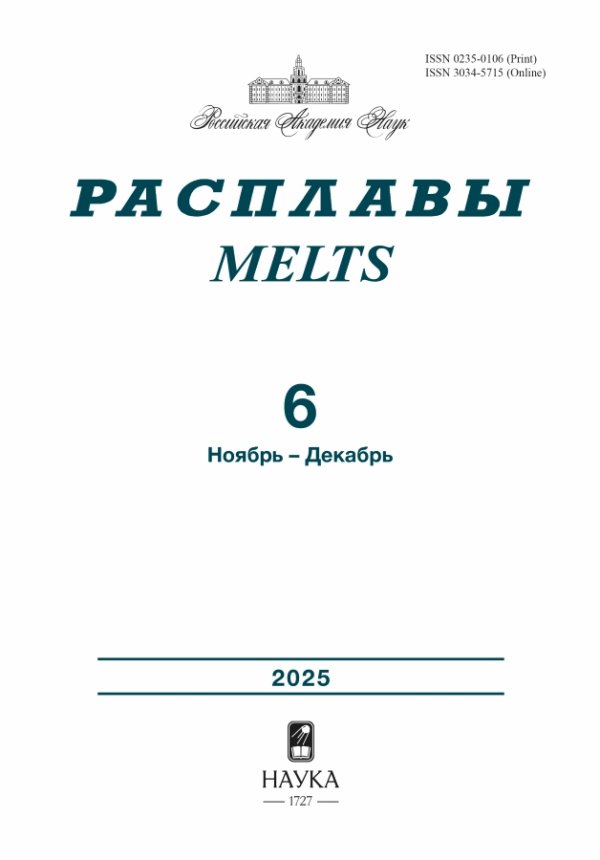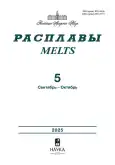Geometrical limit of density for random ensembles of regular polygons
- Authors: Shubin A.B.1
-
Affiliations:
- Institute of Metallurgy of the Ural Branch of the Russian Academy of Sciences
- Issue: No 5 (2025)
- Pages: 492-506
- Section: Articles
- URL: https://bakhtiniada.ru/0235-0106/article/view/309554
- DOI: https://doi.org/10.31857/S0235010625050076
- ID: 309554
Cite item
Abstract
The paper studies statistical and geometric properties of random two-dimensional ensembles of regular polygons (with the number of vertices n from 3 to 15), obtained by densification of “starting” sparse packings using the modified Lubachevsky-Stillinger algorithm (LS ). Pair correlation functions for the specified packings are in good agreement with the results of other works. The evolution of these functions during the transition from the initial to the final density values and partial “crystallization” of the ensembles is presented in the form of 3D graphs. A statistical-geometric function of the excluded area for an ensemble of particles is proposed and studied, which is well described by a simple relation: (η) = a + b · lnη, where η is the fraction of the area of the ensemble occupied by particles, a and b are coefficients. The point of intersection of the graph of this function with the curve describing the dependence of the average area of the Voronoi region from η, defines the geometric limit of density ηmaxfor a random ensemble of particles (polygons or hard disks). For the considered two-dimensional ensembles of regular polygons, the value of ηmaxdepends relatively weakly on the shape of the particles and lies within the range of 0.680 (15-gons) – 0.694 (triangles). As the number of vertices increases, ηmaxnaturally tends to that for a random ensemble of hard disks. The values of the maximum density for the latter are obtained by extrapolating the dependence ηmax(n), and directly by modeling the hard disk system. The indicated values are almost identical and are (respectively): 0.6793 ± 0.0001 and 0.6792 ± 0.0002.
About the authors
A. B. Shubin
Institute of Metallurgy of the Ural Branch of the Russian Academy of Sciences
Author for correspondence.
Email: fortran@list.ru
Amunson St., 101, Yekaterinburg, 620016
References
- Duparcmeur Y.L., Troadec J.P., Gervois A. Random close packing of regular polygons // Journal de Physique I. 1997. V.7. № 10. P. 1181–1189. https://doi.org/10.1051/jp1:1997115
- Anderson J.A., Antonaglia J., Millan J.A., Engel M., Glotzer S.C. Shape and Symmetry Determine Two-Dimensional Melting Transitions of Hard Regular Polygons // Physical Review X. 2017. V.7. P. 021001 (1–14). https://doi.org/10.1103/PhysRevX.7.021001
- Shen H., Tong H., Tan P., Xu L. A universal state and its relaxation mechanisms of long-range interacting polygons // Nature Communications. 2019. V.10:1737 (1–8). https://doi.org/10.1038/s41467-019-09795-6.
- Loffler R., Siedentopa L., Keim P. Tetratic phase in 2D crystals of squares // Soft Matter. 2025. V.21. P. 2026–2032. https://doi.org/10.1039/d4sm01377h
- Odriozola G., Gurin P. Phase boundaries of bulk 2D rhombi // Computational Materials Science. 2024. V.237. P. 112919 (1–8). https://doi.org/10.1016/j.commatsci.2024.112919
- Hua P., Han Y. Searching for various melting scenarios of 2D crystals // Matter. 2024. V.7. № 1. P. 19–22. https://doi.org/10.1016/j.matt.2023.12.013
- Shen W., Antonaglia J., Anderson J.A., Engel M., Van Anders G., Glotzer S.C. Symmetries in Hard Polygon Systems Determine Plastic Colloidal Crystal Mesophases in Two Dimensions // Soft Matter. 2019. V.15. P. 2571–2579. https://doi.org/10.1039/C9SM00016J
- Ciesla M., Kubala P. Random sequential adsorption of aligned regular polygons and rounded squares: Transition in the kinetics of packing growth // Physical Review E. 2023. V.107. P. 054904(1– 7). https://doi.org/10.1103/PhysRevE.107.054904
- Atkinson S., Jiao Y., Torquato S. Maximally dense packings of two-dimensional convex and concave noncircular particles // Physical Review E. 2012. V.86. № 3. P.031302. https://doi.org/10.1103/PhysRevE.86.031302 (1–11).
- Wang C., Dong K., Yu A. Structural characterization of the packings of granular regular polygons // Physical Review E. 2015. V.92. P. 062203(1–12). https://doi.org/10.1103/PhysRevE.92.062203
- Stannarius R., Schulze J. On regular and random two-dimensional packing of crosses // Granular Matter. 2022. V.24. № 25. P. 1–15. https://doi.org/10.1007/s10035-021-01190-7
- Aponte D., Estrada N., Bares J., Renouf M., Azema E. Geometric cohesion in two-dimensional systems composed of star-shaped particles // Physical Review E. 2024. V.109. P. 044908-1–044908-11. https://doi.org/10.1103/PhysRevE.109.044908
- Speedy R.J. On the reproducibility of glasses // J. of Chemical Physics. 1994. V.100. P. 6684–6691. https://doi.org/10.1063/1.467028
- Lubachevsky B.D., Stillinger F.H. Geometric properties of random disk packings // Journal of Statistical Physics. 1990. V.60. № 5/6. P. 561–583. https://doi.org/10.1007/bf01025983
- Kumar V.S., Kumaran V. Voronoi neighbor statistics of hard-disks and hard-spheres // Journal of Chemical Physics. 2005. V.123. P. 074502 (1–10). https://doi.org/10.1063/1.2000233
- Donev A., Stillinger F.H., Torquato S. Do Binary Hard Disks Exhibit an Ideal Glass Transition? // Physical Review Letters. 2006. V.96. P. 225502(1–4). https://doi.org/10.1103/PhysRevLett.96.225502
- Blumenfeld R. Disorder criterion and explicit solution for the disc random packing problem // Physical Review Letters. 2021. V.127. P. 118002 (1–5). https://doi.org/10.1103/PhysRevLett.127.118002
- Brouwers H.J.H. A geometric probabilistic approach to random packing of hard disks in a plane // Soft Matter. 2023. V.19. P. 8465–8471. https://doi.org/10.1039/d3sm01254a
- Thorneywork A.L., Abbott J.L., Aarts D.G.A.L., Dullens R.P.A. Two-Dimensional Melting of Colloidal Hard Spheres // Physical Review Letters. 2017. V.118. P. 158001 (1–5). https://doi.org/10.1103/PhysRevLett.118.158001
- Sun X., Li Y., Ma Y., Zhang Z. Direct observation of melting in a two-dimensional driven granular system // Scientific Reports. 2016. V.6. P. 24056 (1–7). https://doi.org/10.1038/srep24056
- Engel M., Anderson J.A., Glotzer S.C., Isobe M., Bernard E.P., Krauth W. Hard-disk equation of state: First-order liquid-hexatic transition in two dimensions with three simulation methods // Physical Review E.2013. V.87. P. 042134 (1–8). https://doi.org/10.1103/PhysRevE.87.042134
- Truskett T.М., Torquato S., Sastry S., Debenedetti P.G., Stillinger F.H. Structural precursor to freezing in the hard-disk and hard-sphere systems // Physical Review E. 1998. V.58. № 3. P. 3083–3088. https://doi.org/10.1103/PhysRevE.58.3083
- Zong Y., Zhao K. Manipulation of self-assembled structures by shape-designed polygonal colloids in 2D // Current Opinion in Solid State and Materials Science. 2022. V.26. P. 101022 (1–9). https://doi.org/10.1016/j.cossms.2022.101022
- Dertli D., Speck T. In pursuit of the tetratic phase in hard rectangles // Physical Review Research. 2025. V.7. P. L012034 (1–6). https://doi.org/10.1103/PhysRevResearch.7.L012034
- Yu T., Mason T.G. Heptatic liquid quasi-crystals by colloidal lithographic pre-assembly // Journal of Colloid And Interface Science. 2024. V.665. P. 535–544. https://doi.org/10.1016/j.jcis.2023.12.157
- Xu X., Rice S.A. Maximally random jamming of one-component and binary hard-disk fluids in two dimensions // Physical Review E. 2011. V.83.P. 021120(1–9). https://doi.org/10.1103/PhysRevE.83.021120
- Shubin A.B. O maksimal`noj plotnosti sluchajnoj upakovki odinakovy`x tverdy`x sfer. // Rasplavy`. 1995. № 1. S. 92–97. [In Russian]
- Shubin A.B. Concerning the geometric limit of the density of a loose medium modeled by identical spherical particles // J. of Engineering Physics and Thermophysics. 1995. V.68. № 4. P. 460–463. https://doi.org/10.1007/BF00858659
- Shubin A.B. The Geometric Condition for Density Limits in Idealized Models of Liquids // Russian Journal of Physical Chemistry. 1996. V.70. № 4. P. 711–712.
- Shubin A.B., Yatsenko S.P. Geometric constraints for the density limit in the two-dimensional model of liquid // Russian Journal of Physical Chemistry A. 1999. V.73. № 1. P. 140–141.
- Shubin A.B. Structural characteristics of a small group of fixed particles and the maximum density of a random packing of hard spheres // Russian Metallurgy (Metally). 2021. № 2. P. 181–186. https://doi.org/10.1134/S0036029521020245
- Geigenfeind T., de las Heras D. Principal component analysis of the excluded area of two-dimensional hard particles // Journal of Chemical Physics. 2019. V.150. P. 184906 (1–13). https://doi.org/10.1063/1.5092865
- Martinez-Raton Y., Velasco E. Orientational ordering in a fluid of hard kites: A density-functional-theory study // Physical Review E. 2020. V.102. P. 052128 (1–16). https://doi.org/10.1103/PhysRevE.102.052128
- Onsager L. The Effects of Shape on the Interaction of Colloidal Particles // Annals New-York Academy of Sciences. 1949. V.51. P. 627–659. https://doi.org/10.1111/j.1749-6632.1949.tb27296.x
- Browers H.J.H. Random packing fraction of binary similar particles: Onsager’s excluded volume model revisited // Physics – Uspekhi. 2024. V.67. № 5. P. 510–529. https://doi.org/10.3367/UFNe.2023.11.039606
- Galindo-Torres S.A., Munoz J. D. Minkowski-Voronoi diagrams as a method to generate random packings of spheropolygons for the simulation of soils // Physical Review E. 2010. V.82. P. 056713 (1–12). https://doi.org/10.1103/PhysRevE.82.056713
- Ciesla M., Kubala P., Kozubek K. Algorithms to generate saturated random sequential adsorption packings built of rounded polygons // Physical Review E. 2021. V.103. P. 063308 (1–10). https://doi.org/10.1103/PhysRevE.103.063308
- Shubin A.B. Random ensembles of particles with pentagonal symmetry: densification and properties // Melts. 2025. № 1. P. 8–18. https://doi.org/10.31857/S02350106250102e3
- Ciesla M., Kubala P., Zhang G. Saturated random packing built of arbitrary polygons under random sequential adsorption protocol //Physical Review E. 2019. V.100. P. 062901-1–062901-7. https://doi.org/10.1103/PhysRevE.100.062901
- Zhang G. Precise algorithm to generate random sequential adsorption of hard polygons at saturation // Physical Review E. 2018. V.97. P. 043311 (1–5). https://doi.org/10.1103/PhysRevE.97.043311
- Jiao Y., Torquato S. Maximally random jammed packings of Platonic solids: Hyperuniform long-range correlations and isostaticity // Physical Review E. 2011. V.84. P. 041309 (1–7). https://doi.org/10.1103/PhysRevE.84.041309
- Baranau V., Tallarek U. Relaxation times, jamming densities, and ideal glass transition densities for hard spheres in a wide range of polydispersities // AIP Advances. 2020. V.10. P. 035212 (1–12). https://doi.org/10.1063/1.5140365
Supplementary files









